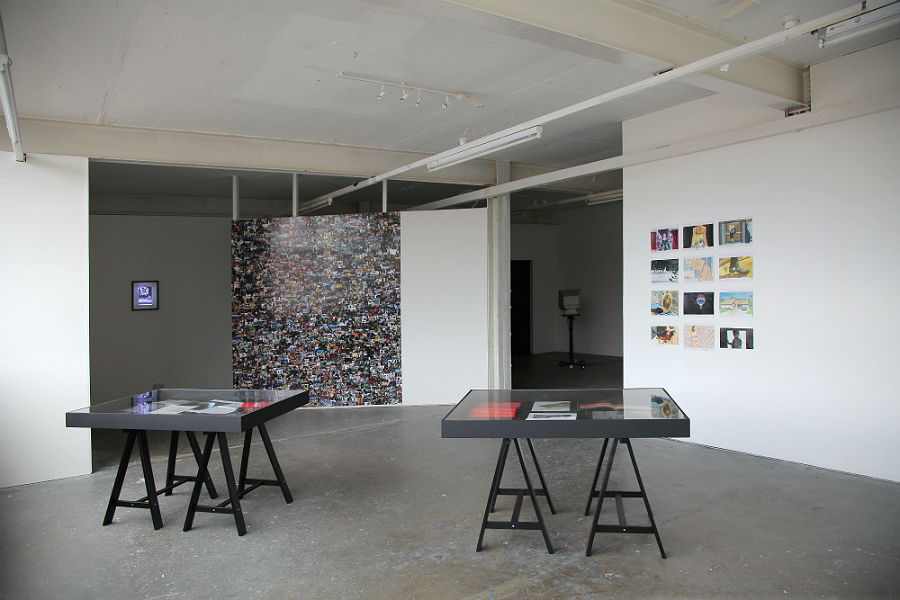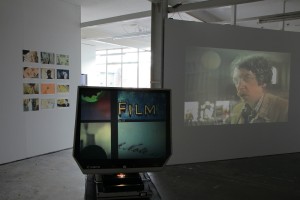Misdirect Movies – Reviewed

For the latest exhibition at The Royal Standard, co-curators Andrew Bracey and John Rimmer take the world of film as inspiration…
When we arrive at the Royal Standard, we creep in, running late for Cathy Lomax’s talk. Lomax, artist and editor of publications Garageland and Arty, is talking about her Film Diary paintings, which cover “everything from high-brow to very low, there is no hierarchy”. She’s not kidding, painting as she has, everything from Twilight to Brighton Rock and Casablanca.
A good fit for this exhibition, the two publications we mention above – Garageland, in Lomax’s words, “quite glossy”, while Arty is a handmade ‘zine – have in the past given over entire issues to the subject of film. Curated by Andrew Bracey and John Rimmer, using “cinema’s near endless supply of imagery” as a starting point, each of the seven exhibiting artists produce markedly different results.
Starting with Lomax and those Film Diary pieces (of which she has produced around 400 since August 2009); we can’t help but be transfixed by their apparent simplicity – take a swift glance and there’s much to miss. Imbued with hidden depths and subtle beauty, there are layers to peel away at here, with each piece accompanied by a line of text providing an extra strand of narrative.
For instance, the line: “She didn’t know anyone was watching as she left his cabin” renders one piece incredibly meaningful, exciting and salacious. On discovering what we’re looking at is actually from Dirty Dancing, we’re stunned, believing initially it must be referencing a dark and much more intellectually rewarding piece of cinema. But even when we recognise much loved scenes and characters, Lomax’s work is uncanny in encouraging us to think again about something we assumed we knew so well.
A similarly mesmerising, yet altogether different piece, is Andrew Bracey’s The Six Most Beautiful Minutes in the History of Cinema. We’re back to spot the film again, but this time we are faced with an imposing collage of stills taking up an entire temporary wall in the gallery space. Do these images really constitute cinematic history’s six most beautiful minutes? We’re not sure, but is that not part of the fun? We all have our favourites. Beginning life as a montage of images extracted from 2880 scenes of cinema, it invites the viewer to compare, even judge, their tastes against Bracey’s.
On the opposite side of this wall is Elizabeth McAlpine’s The Film Footage Missed By A Viewer Through Blinking While Watching The Feature Film ‘Don’t Look Now’, which does exactly what it says on the tin. We like this piece immediately, but then wonder whether we would feel this way had McAlpine used something other than one of the most iconic (and one of our favourite) movies of all time. We suspect not, but the opportunity to see Julie Christie and Donald Sutherland recontextualised in such a way remains irresistible.

Dragging ourselves away from Venice in fast forward, we encounter Dave Griffiths’s Columbarium (above), with which he presents a selection of stills from classic films in a microfiche viewer – technology more at home in an ’80s library. The joy is being allowed to fiddle about with it; move a black plastic square around underneath the screen and the shot changes, like using a viewfinder as a kid.
Griffiths is an artist obsessed with cue dots, those visual indicators in the top corner of a film used to tell the projectionist that the reel is ending. It is, as he puts it, “the archaeology of movie changeovers” that interests him, that cue being a signal of the ending or change in narrative, or the pace and structure of a story, as well as representing the nostalgia we feel about analogue film.
Speaking of which, we nearly miss David Reed’s The Searchers, behind black curtains and off in a corner screening room. Supplanting silhouetted figures from John Ford’s 1956 (John Wayne-starring) Western of the same name onto close ups of his own paintings, it is a piece – as with McAlpine’s use of Nic Roeg’s film – which relies on a shifting of context for its impact. What that impact is, we’re not certain, but it is at least amusing and diverting to hear The Searchers title track drifting around Vauxhall rather than the old west.
Less diverting is Berlin-based Rosa Barba’s work. Housed in a pair of vitrines, publication Printed Cinema feels a little redundant. Sourced from film stills, text and photographs, what could have made a fascinating addition is rendered inert, which (given our obsession with printed matter) seems a shame. Also difficult to engage with are a pair of works by John Rimmer. In My Room, a painting produced using adverts rather than movies as inspiration, somehow falls flat. Of more interest is his projected piece, Derivatives, made up of a collection of images from various sources, evoking the constant, 24 hour bombardment of information we sustain on a daily basis.
One wonders if Rimmer, whose pieces are decidedly un-filmic, and therefore less immediate than some of the others, could have benefited from more context. Minor quibbles aside, taken as a whole, Misdirect Movies is a success, and proves beyond any doubt that movies – as with all forms of visual art – produce exceptionally different results and responses from us all.
Images courtesy Mary Stark
Misdirect Movies continues @ The Royal Standard until 31st March





